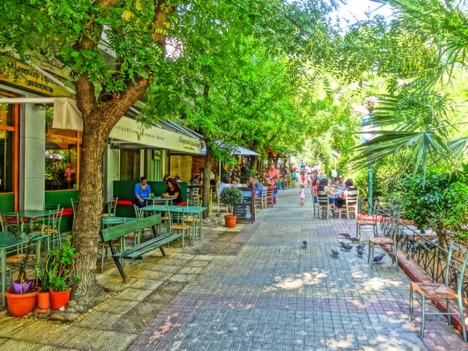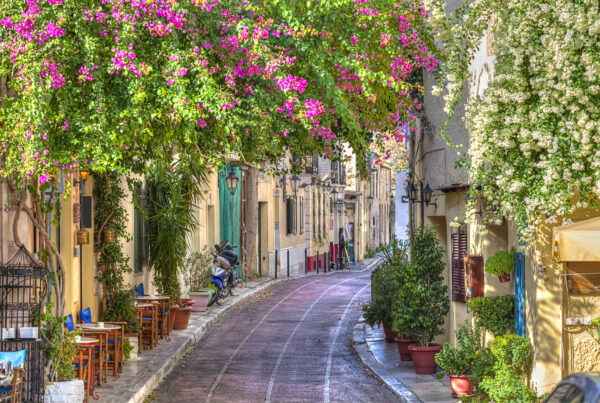Metaxourgeio (often referred to as Kerameikos, as this area is nestled within Metaxourgeio), is an area in Athens that has gone through many changes throughout the years, is still evolving and currently is characterized by low-key & freewheeling vibes. A walk through Metaxourgeio reveals the rise, fall and resurgence of the neighborhood through its architecture and art.
In Metaxourgeio you will see large modern buildings standing next to crumbling, abandoned buildings that retain ornate neoclassical elements. Some of the latter have been salvaged, restored and repurposed into performance spaces, bars, cafes and restaurants. The narrow streets and the occasional cobblestone pedestrian alley helps to create a village ambience. Athens’ bustling and chaotic vibe drastically slows down here. This district is a favourite of locals who prefer the area’s atmosphere more than that of Psyrri or Gazi, and visitors who appreciate authenticity and off the beaten path discoveries.

Originally a thriving working-class neighborhood, many craftsmen, tradesmen, and small-business owners, arrived here upon the construction of the Silk Factory (Metaxourgeio means “silky”) in the early 19th century. Metaxourgeio was practically abandoned starting in the 1970s, but thanks to the 2004 Olympic Games, renovation projects to create modern lofts and the construction of other infrastructure buildings led to an influx of new higher-income residents. The actual Silk factory has now become the Municipal Gallery of Athens, and is among the city’s most important surviving neoclassical structures (designed in 1833 by the Danish architect Hans Christian Hansen).
Metaxourgeio is a neighborhood with clear geographical boundaries. It extends north up to Konstantinoupoleos Street, south to Pireos Street, east to Kolokynthous Street and west to Thermopylon Street. Just a 10min walk from Monastiraki square.

Metaxourgeio is now an artistic, authentic and trendy neighborhood due to the opening of several art galleries, a few museums, and many trendy restaurants and cafés. The heart of the neighborhood is Avdi Square, which draws in residents and visitors with its open space, greenery, cafés, bars, restaurants, theatres and art gallery.
One of our favorite pedestrian streets is Paramythias, as you can enjoy buildings from different eras, some renovated some not, as well as one of our best loved “all day” bars called “Beauty Killed the Beast”, which is ideal for coffee, brunch or evening drinks.

One other characteristic of Metaxourgeio is the Street Art that can be found everywhere, adding a quirky & riveting artistic touch to brick walls and dilapidated buildings.
Metaxourgeio is undoubtedly one of the coolest neighborhoods in Athens, popular for its nightlife, high end restaurants, traditional simple Greek taverns, creative mezedopolia (small plates, like tapas), cafes with beautiful secret gardens and art galleries. The effort to beautify and invigorate the area continues to this day.

Metaxourgeio is more vibrant during the afternoon/ evening and on weekends, but there are also few interesting places to explore during the day.
- The Ancient Cemetery of Kerameikos

Kerameikos was a village settled by potters, and thus became the birthplace of the iconic “Attic” vases/ceramics (thus the name) of Ancient Greece. A section of Kerameikos, situated not far from the riverside, was constantly damaged by river over-flows, which is one of the reasons this area was converted into a graveyard, later becoming the most notable cemetery of ancient Athens (around 1200 BC).
The site was uncovered in 1861 during the construction of Pireos Avenue and has undergone a number of archaeological excavations in recent years, though the excavated area covers only a small portion of the ancient demos (municipality). Many of the findings from the site can be viewed at the Kerameikos Archaeological Museum, built in 1937 and renovated ahead of the 2004 Olympic Games. It houses almost exclusively funerary art and burial goods discovered there; these include statues, steles, ceramics, jewelry and more. Most of the funerary monuments that you will see today are dated from the 4th Century BC.
At the entrance to the site, one can see the remains of the “Long Walls” which ran all the way down to the port of Piraeus. To the left of the entrance is the Museum, and the path that leads you to the “Street of the Tombs”, where the land is lined with plots from wealthy Athenian families.
Between the Sacred and Dipylon Gates are the foundations of the Pompeion, used as a dressing room for participants in the Panathenaic Procession.
When visiting the Kerameikos today, it is advised to first stop on the small rise (South Hill) overlooking the park, where you will find an excellent site map and a panoramic view. Once oriented, you might descend to the right, entering the Street of the Tombs
It’s a lush & tranquil site that does not attract as many visitors as other ancient sites, thus making it ideal to enjoy in a more relaxed way.



Main entrance Ermou 148. (5min walk from Thissio train station, 10min walk from Monastiraki or Kerameikos metro station. Click on the link for opening hours and ticket information http://odysseus.culture.gr/h/3/eh355.jsp?obj_id=2392
2) Athens Municipal Art Gallery

The building was the original the silk factory that gave the district of Metaxourgio (metaxi is Greek for ‘silky’) its name. The gallery contains about 3,000 pieces, most of them painted by 19th and 20th century Greek artists. The Gallery’s collection of engravings is equally remarkable, featuring examples of the pioneers of this art in Greece. The Gallery’s sculpture collection is not as rich and representative as its paintings and engravings, butnonetheless, includes some fine works by artists such as Michalis Tobros & Thanassis Apartis,
The historical and intellectual identity of the collection was shaped by the artistic and social history of modern Greece. Besides its permanent exhibition, the Gallery organises solo and group periodic exhibits in collaboration with other cultural institutions. Frequently, the Municipal Gallery organizes seminars and workshops for children.

Address and contact details: Myllerou 32 and Leonidou (Avdi Square), 9 min walk from Metaxourgeio metro station) +30 210 3243023, Admission to the Municipal Gallery is free for all visitors. http://www.athensmuseums.net/museum.php?id=25&tag=hours
3) The Benaki Museum of Islamic Art

The Museum of Islamic Art is housed in a renovated neoclassical building, that opened in 2004 to house the collection curated by Antoni Benaki during the early part of the 20th century, while he was living in Egypt.
Subsequently enriched by other donations, today it contains c. 10,000 objects from the Middle East, Iran, Turkey, North Africa and India. It demonstrates the evolution of Islamic art up to the Ottoman period and corresponding developments to the middle of the 20th century. The collection includes ceramics, metalwork, jewelry, textiles, woodwork, glassware, ivories, funerary steles and arms and armour.
This is one of the world’s top collections of Islamic art, geographically and chronologically. The collection covers a broad swathe of time and an equally large band of geography, with exhibits from India, the Middle East, Asia Minor, North Africa, and Spain.
During preservation work, a large section of the ancient city wall of Athens from the 4th century BC was uncovered and remains in situ at basement level, accessible to visitors.Insiders tips: 1) The Benaki Museum of Islamic Art is also home to one of the most extraordinary museum (rooftop) cafés in Athens, which overlooks the ancient Keramikos cemetery and displays a lovely mural: Imagine a Palm Tree by Narvine G Khan-Dossos. The colourful installation creates a visual representation of Greece’s proverbial location on the crossroads between East and West. 2) A Ticket to “The Benaki Museum Experience” priced at €30, entitles the visitor to one entrance per exhibition in all of the Benaki Museum buildings in Athens, and is valid for 3 months.



Address & Contact Details: 22 Ag. Asomaton & 12 Dipilou St. Opening Hours: Thursday, Friday, Saturday, Sunday:10:00 – 18:00, +30 210 325 1311. Nearest metro station Thisio 4min walk or 8min walk from Monastiraki square.https://www.benaki.org/index.php?option=com_buildings&view=building&id=15&lang=en
4) Street Art
Athens is a city filled with graffiti and painted murals of all kinds. When exploring Athens, enjoy the abundant street art as this can be a great way to gain an understanding of the city’s character. Athens has a contemporary heart as well, and it beats as loud as her ancient legacy!The hazy gray urban landscape gives way to the colorful creations of street artists all over Metaxourgeio.






